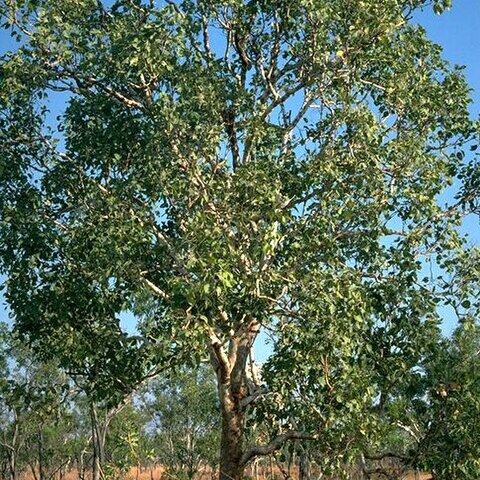Tree to 10 m tall. Forming a lignotuber. Dry season deciduous.Bark thinly persistent and rough, ± tessellated, brown to grey or reddish, variably extending over the lower trunk, sometimes the whole trunk and occasionally the larger limbs, shedding in flakes above to show smooth white to cream and grey. Branchlets lack oil glands in the pith; smooth.Juvenile growth (coppice or field seedlings to 50 cm): stems rounded in cross-section, smooth; juvenile leaves always petiolate, opposite to sub-opposite or alternate, very large, orbicular to broadly ovate or ± oblong, 17–25 cm long, 15–18.5 cm wide, base truncate and sometimes uneven on either side of the petiole, apex usually rounded and apiculate, rarely emarginate, margin usually coarsely crenulate, undulate, dull, green, smooth.Adult leaves predominantly alternate, sometimes a few sub-opposite to opposite pairs present, petioles 1.8–4(5.3) cm long; blade usually broadly ovate to broadly lanceolate, rarely deltoid or ± orbicular, (8)10–27.5 cm long, 4–13.5 cm wide, base truncate to rounded, tapering, or sometimes uneven on either side of the petiole, margin entire, apex rounded and apiculate or pointed, concolorous, dull, green, smooth, side-veins at greater than 45° to midrib (penniveined), reticulation very dense, intramarginal vein apparently absent (confluent with margin) or rarely visible and very close to margin, oil glands apparently absent.Inflorescence terminal compound, less commonly axillary compound, rarely a few single axillary umbels, peduncles stout or relatively slender, rounded, 0.9–5 cm long, buds 7(9) per umbel, pedicels 0.5–1.4(1.7) cm long. Mature buds obovoid to pyriform, 0.9–1.4 cm long, 0.7–0.9 cm wide, smooth, scar absent (both opercula shed together at flowering), operculum shallowly rounded and sometimes umbonate, rarely the umbo slightly elongated into a beak, stamens inflexed, all fertile, anthers oblong, dorsifixed, versatile, dehiscing by longitudinal slits, style as long as or almost as long as floral cavity, straight, stigma blunt or papillose (mop like), locules 4, the vertical ovule rows indistinct on the placentae or ca 7. Flowers creamy white.Fruit pedicellate (pedicels 0.3–1.7 cm long), urceolate with a vertical neck that is flared or not flared at the rim, 2.2–3 cm long, 1.4–2.4 cm wide, ± smooth, disc descending vertically or sometimes obliquely when the rim is flared, valves 4, enclosed.Seeds brown, 10–15 mm long, ellipsoidal with terminal wing, hilum ventral. Cultivated seedlings (measured at ca node 10): cotyledons large, reniform; stems rounded in cross-section, setose with bristle-glands; leaves always petiolate (petioles to 1 cm), opposite for 11 or more nodes, or becoming sub-opposite or alternate earlier, broadly elliptical to ovate, 8–12 cm long, 4–6 cm wide, base rounded to truncate, margin subcrenulate to entire, apex rounded or broadly acute, green, ± concolorous, sparsely setose by node 10 with bristle-glands only on the margin, midrib on underside and petiole.
More
Tree to 10 m, usually somewhat straggly. Bark smooth, white, with short stocking of red-brown scaly bark; on smaller trees red-brown scaly bark on most of trunk, sometimes throughout. Juvenile leaves soon alternate, shortly petiolate, ovate, sparsely setose at least on midrib below. Intermediate leaves broadly ovate to ovate-oblong, to 30 cm long and 20 cm wide. Adult leaves alternate, ovate or lanceolate-ovate to suborbicular, acute, thick; lamina 10–16 cm long, 3–10 cm wide, dull, green, concolorous; lateral veins prominent, at 60°–75°; intramarginal vein confluent with margin; petiole 20–30 mm long. Umbels 3–7-flowered; peduncle 10–30 mm long; pedicels 5–13 mm long. Buds clavate, pyriform or obovoid; operculum depressed hemispherical-conical, 2–3 mm long, 6–7 mm wide; hypanthium hemispherical or truncate-pyriform, 7–10 mm long, 6–8 mm wide. Fruits urceolate or truncate-ovoid, 20–26 mm long, 16–20 mm wide. Seeds winged, yellow-brown.


